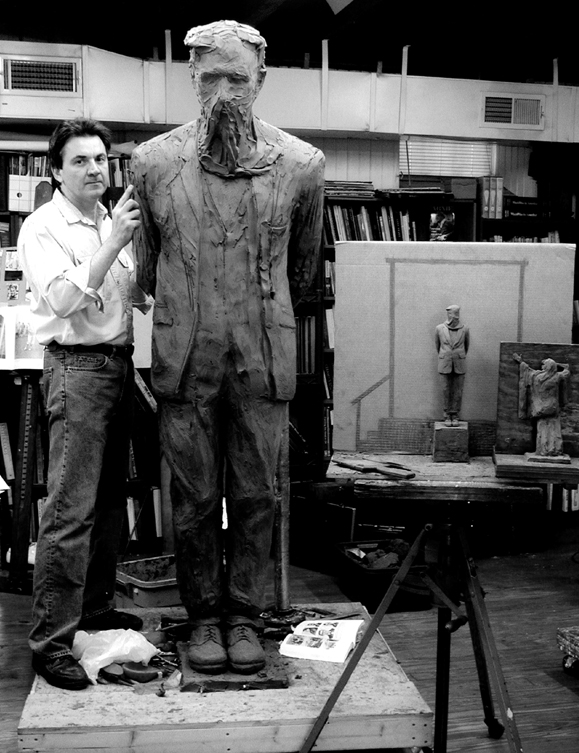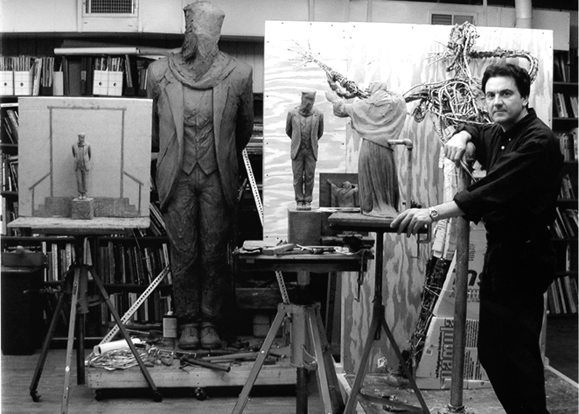Controversy haunts memorial to the Molly Maguires.
℘℘℘
On 21 June 2002, to commemorate the 125th anniversary of the hanging of the Molly Maguires — ten Irish Catholic anthracite coal miners convicted of intimidation and murder by an impartial jury of non-peers — ten men who led the miners’ fight against capitalist oppression through the Workingmen’s Benevolent Association of Schuylkill County, Pennsylvania — the Borough of Mahanoy City (PA) will officially dedicate its publicly funded sculpture installation in the Molly Maguire Historical Park.
By building this park, officials and supporters are confronting the long muffled violent legacy of the Mollies and contesting the harsh criticism of opponents — some of whom are Molly descendants — who call the sculpture a depraved attempt to re-tell the tragic past in a sensationalist effort to promote tourism.
Molly historian Mark Major sees the park as a monument to all the victims of the Molly era — those who lost their lives — justly or unjustly — and to their families. “I believe we have ignored the Mollies and their story,” Major explains. “Their history has split the local Irish American community. This project will recognize the significance of this story…it will present the facts, it will not judge…it will publicly tell the story of capital versus labor, Protestant versus Catholic, everybody versus the Irish.”
The commissioned sculpture by Philadelphia artist Zenos Frudakis is being promoted as an educational tool that will invite a social re-thinking of Mollies. “I did not create my sculpture to be a tribute,” the artist explains, “I created my sculpture to immediately represent the Molly Maguires…to detail the defining moment in Molly history, the moment before hanging, symbolized by the single faceless and hooded man on a scaffold [accompanied by a grieving woman below]…the emotional impact of my imagery provokes a reconsideration of history.”

That history — created by Franklin B. Gowen, president of the politically influential Philadelphia and Reading Iron and Coal Company — included hiring a Pinkerton Detective to infiltrate the local miners’ union, feeding the Molly story to capitalist-friendly publications like The New York Herald and The New York Times, using contacts to become the State’s prosecuting attorney, and securing — from the sole testimony of Pinkerton undercover agent James McParland, an Irish native of dubious repute — the death sentence for all convicted men. Execution was more than a legal victory for Gowen; it represented an economic and political victory of capital over labor.
Pottsville (PA) AOH President Joe Wayne — a descendant of reputed Molly leader Jack Kehoe — fiercely opposes the park for its depraved sculptural representation of the Mollies and its erroneous location. “Park advocates say the sculpture captures the defining moment of the Molly Maguires,” Wayne states. “I disagree…The design is a sensationalist attempt to attract tourists to Mahanoy City, which was not a focal point for Molly activity. This project is about vying for the mighty tourist dollar, not about representing the families on both sides who suffered from Molly violence…they [park officials] did not ask for community input, they created what they wanted. I think it’s presumptuous of them to think they are making a statement for the whole region…the story needs to be told, but not this way.”
“This project is an educational tool for our youth who are unaware of what happened on their own soil,” explains Patty Schnitzius, an Irish Catholic borough council member for Mahanoy City, “and will help our community begin to publicly talk about our Molly history.” Spearheaded by State Representative Edward J. Lucyk, the park embodies, for Schnitzius, the emotional truth of Molly history: “The defining moment for Catholics is Christ’s crucifixion, for Mollies it’s the hanging. This sculpture asks us to question why this happened.”
The guilt of the hanged men may never be fully understood, but Mahanoy City is asserting that its Molly Maguire Historical Park will help ease the anger and pain created from 125 years of silence. “This project has great potential to resolve problems caused by misunderstanding,” explains Major, who is also executive director of the Mahanoy City Visitors Bureau. “This project is for heritage, not for tourism.” ♦


Leave a Reply